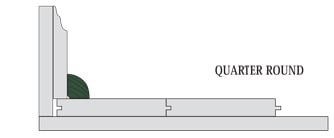Moldings & Trim
Flooring Accessories - Molding and Trim Buying Guide
We offer trim and molding to match your earth-friendly hardwood, cork, and Marmoleum floors as well as carpet!
You're installing a beautiful new sustainable floor but don't forget about the trim and molding pieces to complete the look and pull it all together.
We offer coordinating accessories to match your specific solid or engineered floor, typically constructed from the same high-quality, eco-friendly species and colors as your flooring.
Please call us at 888-447-9877 or email us and we'll find the perfect trims to complement your new floor!
Let's take a look at some of the most popular floor molding and trim types.
Note that dimensions, profiles, and material will vary by flooring type as well as the specific manufacturer but the following descriptions offer a general guideline for the pieces you may need to finish your flooring project:
| Type | Use | Description | Installation Tips | |
|---|---|---|---|---|
 |
QUARTER ROUND | Base Moldings | A Quarter Round adds a finishing touch while covering the edges of the flooring where it meets the wall (or other vertical surfaces). It hides the small gap between the flooring and the wall, known as the expansion gap. It can also be used underneath cabinets in the kitchen! |
This should be used in the final stage of installation and can be used alone or in conjunction with a wall base. Fasten the molding to the wall, wall base or cabinet, NOT to the newly installed flooring. |
 |
T-MOLDING | Transitions (Overlap even height surfaces) | A T-Molding is used when you need to transition from the new flooring to an existing hard surface flooring that is the same height or thickness. Typically used in doorways and hallway transitions to blend flooring whether it be to other hard flooring, carpet or tile. | Installation instructions will vary based on the types of the two floors you're joining. For example, installing a t-molding between a stationary floor and a floating floor vs. between two floating floors. When installing, it is important to allow enough space between the two adjoining floors for expansion or contraction. |
 |
REDUCER | Transitions (Flush) | A Reducer is used to transition the new floor to a lower existing floor like linoleum or low pile carpet. It sits flush with the new flooring, as opposed to an Overlap Reducer which allows the new flooring to expand and contract. A reducer is sloped on one side towards the lower floor to create a seamless, smooth transition. It also protects the exposed edge of the new flooring from being damaged. |
Typically used for nail or glue-down installations only. Prior to installing the floor, determine where the reducer will end so you can determine the desired setback distance. Then mark a "STOP" line on the subfloor at which all materials being installed will stop. This insures proper placement of the molding and expansion for floating floor installations. |
 |
OVERLAP REDUCER | Transitions (Overlap) | Overlap Reducers serve as a finishing transition for a new floating floor installation when a gradual transition between floors of different heights is necessary. Designed specifically for floating floor installations. |
When installing Overlap Reducer moldings on a floating floor, it is important not to fasten the Overlap Reducer directly to the new floor as it must be allowed to expand or contract under the lip of the molding. The overlap part of this transition piece is meant to simply rest on the floating floor. |
 |
THRESHOLD | Transitions (Overlap) | The Threshold is typically used at doorways or to transition between floors of different heights. Can be used with wood, cork, bamboo, tile or carpet. Ideal for where the flooring meets a vertical obstacle where it would be difficult to conceal the expansion gap with a Quarter Round or Wall Base, like a fireplace or patio door. | When installing Threshold moldings on a floating floor, it is important not to fasten the Overlap Reducer directly to the new floor as it must be allowed to expand or contract under the lip of the molding. The overlap part of this transition piece is meant to simply rest on the floating floor. |
 |
STAIR NOSE | Stairs | As the name implies, the Stair Nose molding is used for stairs. It's placed on the front edge of the step when you're using the floor boards to cover the stairs. It butts up against the flooring to provide stability and a finished look to the stair. When stairs are involved in a floating floor installation, an Overlap Stair Nose would be used at the top of the staircase, where the new floor meets the first step, or where they step down into another room. |
If you're using flooring and Flush Stair Nose to build treads for a staircase, install the Stair Nosing first and work back toward the riser. Stair Nosing should be fastened to the subfloor, and rest firmly against the front edge of the riser material of the step. |
PLEASE CALL 888-447-9877 TO ORDER!
Sort By: Best match

















